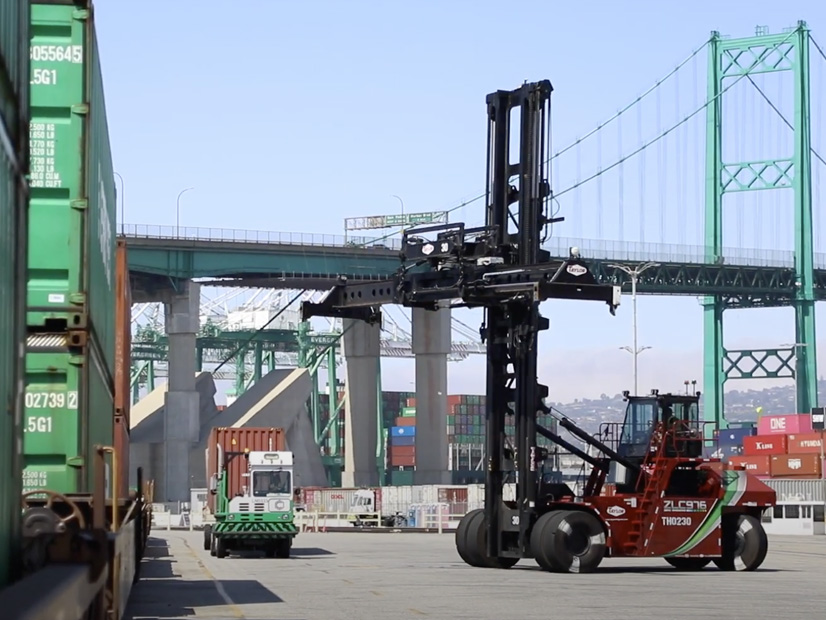
EPA has launched an all-out effort to reduce greenhouse gas emissions and other air pollution at U.S. ports by investing close to $3 billion in federal funds to replace diesel-powered equipment with zero-emissions ships, trucks, trains and other cargo-handling infrastructure.
The lion’s share of the money from EPA’s Clean Ports Program, $2.8 billion, will be awarded through a Zero Emission (ZE) Technology Deployment Competition, which will target “mobile-source” emissions, according to a Feb. 28 announcement. Another $150 million will go to a Climate and Air Quality Planning Competition, to fund a range of climate and air quality initiatives, including emissions inventories, strategy analysis, community engagement and identification of resiliency measures.
The deadline for applications for both programs is May 28, and individual groups or organizations can apply for funding from both programs, according to EPA.
As outlined in the funding announcements, Clean Ports aims to balance the vital role ports play in the U.S. economy with the large amount of air pollution ― including greenhouse gas emissions and small particulate matter ― produced by the diesel-powered trucks, trains and other equipment used at these facilities.
“Our nation’s ports are among the busiest in the world, helping us to create good jobs here in America, move goods, and grow our economy,” EPA Administrator Michael Regan said in the announcement. The new funding from the Inflation Reduction Act would help ensure “America leads in creating globally competitive solutions … [with] cleaner and more efficient technologies while cutting air pollution to protect the people who work at and live near ports.”
“Communities near our nation’s ports are disproportionately impacted by air pollution and other environmental hazards,” said Brenda Mallory, chair of the White House Council on Environmental Quality. “Today’s announcement will help ensure families who live, work and play near our ports have cleaner air to breathe and a healthier environment.”
“There’s an incredible array of new technologies that can make ports cleaner and greener,” National Climate Advisor Ali Zaidi added. “The Clean Ports Program is demonstrating how these technologies can work together.”
Who, What, Where and How Much
Eligible applicants for both funding opportunities are port authorities or state, regional, local or tribal agencies with jurisdiction over a port, air pollution control agencies or private companies that work at or partner with ports.
Equipment eligible for ZE funding includes cargo handling equipment such as tractors, forklifts and top handlers, which are used to move large containers. Trucks, locomotives and rail cars used to transport goods from ports can be funded, along with “harbor craft” such as tugboats, fishing vessels, barges, patrol boats and ferries.
As outlined in the announcement, the ZE competition will include three “tiers” for different sizes and types of ports.
One tier, for large water ports, will award five to 10 grants of $150 million to $500 million, while the second tier for smaller water ports and truck and rail facilities, called “dry ports,” will give out 25 to 70 awards ranging from $5 million to $150 million.
Smaller ports are defined as those that have handled less than 8 million tons of cargo per year for the past three years, based on data from the U.S. Army Corps of Engineers.
A final tier, for tribal applicants at small or dry ports, will provide two to 10 awards of $2 million to $50 million.
The top tier will require 20% in matching funds; smaller and dry port projects will need a 10% match, and tribal awards will cover 100% of costs.
The Climate and Air Quality Planning Competition will provide funding for a broad range of activities, such as collecting and analyzing data for current emissions inventories or projected future inventories, truck counts and traffic studies, and assessing the cost and feasibility of various emissions reduction strategies.
EPA expects to award between 50 and 70 grants, with a minimum amount of $200,000 and a maximum amount of $3 million. The EPA has 10 regional offices across the country, and at least one award will be made in each of these regions. A minimum of 10 awards also will be reserved for small water ports, and at least two for tribal applicants.

